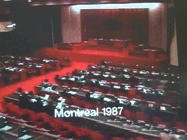|
|
|
INDIA
AND THE MONTREAL PROTOCOL

In
order to preserve the ozone layer, countries across the
globe came together and drew up a global agreement - the
Montreal Protocol. This international treaty aligns
developing and developed countries in the mutual pursuit of
phasing out ODS. Almost 190 countries have signed the
agreement till date. The table below summaries the compounds
and the phase-out schedules of substances regulated by the
Montreal Protocol.
|
Compound
|
Ozone Depleting Potential (ODP)
|
Complete phase out for
|
|
developed countries by 1st Jan of |
article 5 countries by 1st Jan of
|
|
Bromochloromethane
| 0.12
|
2002
|
n/a
|
|
Carbon Tetrachloride (CTC) |
1.1
|
1996
|
2010
|
|
Chlorofluorocarbons (CFCs)
| 0.6-1.0
|
1996
|
2010
|
|
Halons
|
3-10
|
1994
|
2010
|
|
Hydrobromofluorocarbons (HBFC)
| 0.1-14
|
2005
|
2010
|
|
Hydrochlorofluorocarbons (HCFC)
| 0.05
|
2020
|
2030
|
| Methyl Bromide
|
0.6
|
2005
|
2015
|
| 1.1.1-Trichloroethane
| 0.1
|
1996
|
2015
|
THE
MULTILATERAL FUND
The Multilateral Fund (MLF) has been established as a financial instrument of the Montreal Protocol. With funds received from developed countries the MLF assists developing countries in the implementation of the protocol.
IMPLICATIONS
FOR INDIA
India is party to the Montreal Protocol since September 1992 and is listed as an
Article-5 country (developing country). Based on the average production and consumption
of the baseline years 1998 to 2000, the phase-out schedule for CTC stipulates that, both
production and consumption be reduced by 85% by January 1, 2005. CTC has to be phased out
completely by January 1, 2010. In this task GoI is assisted by World Bank and bilateral partners
deputed by France, Germany and Japan.
|
Reduction targets |
|
On January 1, 2005 |
Reduction by 85% to 1,726 MT |
|
On January 1, 2010 |
Reduction by 100% to 0 MT |
|
Baseline consumption: 11,505 MT of CTC per annum |
|
|
 |
|